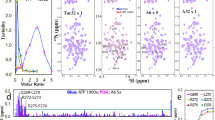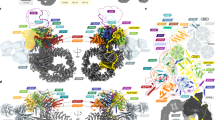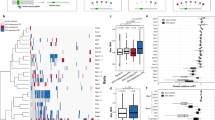Abstract
Signal recognition particle, MinD and BioD (SIMIBI)-type nucleoside triphosphate–binding proteins are an ancient subfamily of nucleotide-binding proteins that serve in a wide range of cellular processes. Notably, this class comprises dimeric ATPases as well as GTPases (SIMIBI 'twins') and a subset of SIMIBI-type proteins, including SRP GTPases, MinD-type ATPases and the Get3 ATPase, is essential to protein targeting and localization. Here, we define common mechanistic principles and differences for these SIMIBI proteins.
This is a preview of subscription content, access via your institution
Access options
Subscribe to this journal
Receive 12 print issues and online access
$189.00 per year
only $15.75 per issue
Buy this article
- Purchase on Springer Link
- Instant access to full article PDF
Prices may be subject to local taxes which are calculated during checkout


Similar content being viewed by others
References
Leipe, D.D., Wolf, Y.I., Koonin, E.V. & Aravind, L. Classification and evolution of P-loop GTPases and related ATPases. J. Mol. Biol. 317, 41–72 (2002).
Kimple, A.J., Bosch, D.E., Giguere, P.M. & Siderovski, D.P. Regulators of G-protein signaling and their Gα substrates: promises and challenges in their use as drug discovery targets. Pharmacol. Rev. 63, 728–749 (2011).
Wittinghofer, A. & Vetter, I.R. Structure-function relationships of the G domain, a canonical switch motif. Annu. Rev. Biochem. 80, 943–971 (2011).
Bourne, H.R., Sanders, D.A. & McCormick, F. The GTPase superfamily: a conserved switch for diverse cell functions. Nature 348, 125–132 (1990).
Gasper, R., Meyer, S., Gotthardt, K., Sirajuddin, M. & Wittinghofer, A. It takes two to tango: regulation of G proteins by dimerization. Nat. Rev. Mol. Cell Biol. 10, 423–429 (2009).
Saraste, M., Sibbald, P.R. & Wittinghofer, A. The P-loop–a common motif in ATP- and GTP-binding proteins. Trends Biochem. Sci. 15, 430–434 (1990).
Vetter, I.R. & Wittinghofer, A. The guanine nucleotide-binding switch in three dimensions. Science 294, 1299–1304 (2001).
Akopian, D., Shen, K., Zhang, X. & Shan, S.O. Signal recognition particle: an essential protein-targeting machine. Annu. Rev. Biochem. published online, http://dx.doi.org/10.1146/annurev-biochem-072711-164732 (13 February 2013).
Grudnik, P., Bange, G. & Sinning, I. Protein targeting by the signal recognition particle. Biol. Chem. 390, 775–782 (2009).
Freymann, D.M., Keenan, R.J., Stroud, R.M. & Walter, P. Structure of the conserved GTPase domain of the signal recognition particle. Nature 385, 361–364 (1997).
Montoya, G., Svensson, C., Luirink, J. & Sinning, I. Crystal structure of the NG domain from the signal-recognition particle receptor FtsY. Nature 385, 365–368 (1997).
Egea, P.F. et al. Substrate twinning activates the signal recognition particle and its receptor. Nature 427, 215–221 (2004).
Focia, P.J., Shepotinovskaya, I.V., Seidler, J.A. & Freymann, D.M. Heterodimeric GTPase core of the SRP targeting complex. Science 303, 373–377 (2004).
Estrozi, L.F., Boehringer, D., Shan, S.O., Ban, N. & Schaffitzel, C. Cryo-EM structure of the E. coli translating ribosome in complex with SRP and its receptor. Nat. Struct. Mol. Biol. 18, 88–90 (2011).
Siu, F.Y., Spanggord, R.J. & Doudna, J.A. SRP RNA provides the physiologically essential GTPase activation function in cotranslational protein targeting. RNA 13, 240–250 (2007).
Ataide, S.F. et al. The crystal structure of the signal recognition particle in complex with its receptor. Science 331, 881–886 (2011).
Shen, K., Arslan, S., Akopian, D., Ha, T. & Shan, S.O. Activated GTPase movement on an RNA scaffold drives co-translational protein targeting. Nature 492, 271–275 (2012).
Zhang, X. et al. Direct visualization reveals dynamics of a transient intermediate during protein assembly. Proc. Natl. Acad. Sci. USA 108, 6450–6455 (2011).
Holtkamp, W. et al. Dynamic switch of the signal recognition particle from scanning to targeting. Nat. Struct. Mol. Biol. 19, 1332–1337 (2012).
Parlitz, R. et al. Escherichia coli signal recognition particle receptor FtsY contains an essential and autonomous membrane-binding amphipathic helix. J. Biol. Chem. 282, 32176–32184 (2007).
Stjepanovic, G. et al. Lipids trigger a conformational switch that regulates signal recognition particle (SRP)-mediated protein targeting. J. Biol. Chem. 286, 23489–23497 (2011).
de Leeuw, E. et al. Anionic phospholipids are involved in membrane association of FtsY and stimulate its GTPase activity. EMBO J. 19, 531–541 (2000).
Bacher, G., Lutcke, H., Jungnickel, B., Rapoport, T.A. & Dobberstein, B. Regulation by the ribosome of the GTPase of the signal-recognition particle during protein targeting. Nature 381, 248–251 (1996).
Bange, G. et al. Structural basis for the molecular evolution of SRP-GTPase activation by protein. Nat. Struct. Mol. Biol. 18, 1376–1380 (2011).
Hegde, R.S. & Keenan, R.J. Tail-anchored membrane protein insertion into the endoplasmic reticulum. Nat. Rev. Mol. Cell Biol. 12, 787–798 (2011).
Formighieri, C., Cazzaniga, S., Kuras, R. & Bassi, R. Biogenesis of photosynthetic complexes in the chloroplast of Chlamydomonas reinhardtii requires ARSA1, a homolog of prokaryotic arsenite transporter and eukaryotic TRC40 for guided entry of tail-anchored proteins. Plant J. 73, 850–861 (2013).
Suloway, C.J., Chartron, J.W., Zaslaver, M. & Clemons, W.M. Jr. Model for eukaryotic tail-anchored protein binding based on the structure of Get3. Proc. Natl. Acad. Sci. USA 106, 14849–14854 (2009).
Denic, V., Doetsch, V. & Sinning, I. Endoplasmic reticulum targeting and insertion of tail-anchored membrane proteins by the GET pathway. Cold Spring Harb. Perspect. Biol. doi:10.1101/cshperspect.a013334 (in the press).
Bozkurt, G. et al. Structural insights into tail-anchored protein binding and membrane insertion by Get3. Proc. Natl. Acad. Sci. USA 106, 21131–21136 (2009).
Mateja, A. et al. The structural basis of tail-anchored membrane protein recognition by Get3. Nature 461, 361–366 (2009).
Chartron, J.W., Clemons, W.M. Jr. & Suloway, C.J. The complex process of GETting tail-anchored membrane proteins to the ER. Curr. Opin. Struct. Biol. 22, 217–224 (2012).
Sinning, I., Bange, G. & Wild, K. It takes two to Get3. Structure 19, 1353–1355 (2011).
Wang, F., Whynot, A., Tung, M. & Denic, V. The mechanism of tail-anchored protein insertion into the ER membrane. Mol. Cell 43, 738–750 (2011).
Mariappan, M. et al. The mechanism of membrane-associated steps in tail-anchored protein insertion. Nature 477, 61–66 (2011).
Stefer, S. et al. Structural basis for tail-anchored membrane protein biogenesis by the Get3-receptor complex. Science 333, 758–762 (2011).
Kubota, K., Yamagata, A., Sato, Y., Goto-Ito, S. & Fukai, S. Get1 stabilizes an open dimer conformation of Get3 ATPase by binding two distinct interfaces. J. Mol. Biol. 422, 366–375 (2012).
Lutkenhaus, J. Assembly dynamics of the bacterial MinCDE system and spatial regulation of the Z ring. Annu. Rev. Biochem. 76, 539–562 (2007).
Wu, W., Park, K.T., Holyoak, T. & Lutkenhaus, J. Determination of the structure of the MinD-ATP complex reveals the orientation of MinD on the membrane and the relative location of the binding sites for MinE and MinC. Mol. Microbiol. 79, 1515–1528 (2011).
Szeto, T.H., Rowland, S.L., Rothfield, L.I. & King, G.F. Membrane localization of MinD is mediated by a C-terminal motif that is conserved across eubacteria, archaea, and chloroplasts. Proc. Natl. Acad. Sci. USA 99, 15693–15698 (2002).
Zhou, H. et al. Analysis of MinD mutations reveals residues required for MinE stimulation of the MinD ATPase and residues required for MinC interaction. J. Bacteriol. 187, 629–638 (2005).
Lackner, L.L., Raskin, D.M. & de Boer, P.A. ATP-dependent interactions between Escherichia coli Min proteins and the phospholipid membrane in vitro. J. Bacteriol. 185, 735–749 (2003).
Cordell, S.C., Anderson, R.E. & Lowe, J. Crystal structure of the bacterial cell division inhibitor MinC. EMBO J. 20, 2454–2461 (2001).
Shen, B. & Lutkenhaus, J. Examination of the interaction between FtsZ and MinCN in E. coli suggests how MinC disrupts Z rings. Mol. Microbiol. 75, 1285–1298 (2010).
Hu, Z. & Lutkenhaus, J. Analysis of MinC reveals two independent domains involved in interaction with MinD and FtsZ. J. Bacteriol. 182, 3965–3971 (2000).
Park, K.T., Wu, W., Lovell, S. & Lutkenhaus, J. Mechanism of the asymmetric activation of the MinD ATPase by MinE. Mol. Microbiol. 85, 271–281 (2012).
Park, K.T. et al. The Min oscillator uses MinD-dependent conformational changes in MinE to spatially regulate cytokinesis. Cell 146, 396–407 (2011).
Scheffzek, K. et al. The Ras-RasGAP complex: structural basis for GTPase activation and its loss in oncogenic Ras mutants. Science 277, 333–338 (1997).
Chevance, F.F. & Hughes, K.T. Coordinating assembly of a bacterial macromolecular machine. Nat. Rev. Microbiol. 6, 455–465 (2008).
Bulyha, I., Hot, E., Huntley, S. & Sogaard-Andersen, L. GTPases in bacterial cell polarity and signalling. Curr. Opin. Microbiol. 14, 726–733 (2011).
Green, J.C. et al. Recruitment of the earliest component of the bacterial flagellum to the old cell division pole by a membrane-associated signal recognition particle family GTP-binding protein. J. Mol. Biol. 391, 679–690 (2009).
Guttenplan, S.B., Shaw, S. & Kearns, D.B. The cell biology of peritrichous flagella in Bacillus subtilis. Mol. Microbiol. 87, 211–229 (2013).
Bange, G., Petzold, G., Wild, K., Parlitz, R.O. & Sinning, I. The crystal structure of the third signal-recognition particle GTPase FlhF reveals a homodimer with bound GTP. Proc. Natl. Acad. Sci. USA 104, 13621–13625 (2007).
Lutkenhaus, J. & Sundaramoorthy, M. MinD and role of the deviant Walker A motif, dimerization and membrane binding in oscillation. Mol. Microbiol. 48, 295–303 (2003).
Daumke, O., Weyand, M., Chakrabarti, P.P., Vetter, I.R. & Wittinghofer, A. The GTPase-activating protein Rap1GAP uses a catalytic asparagine. Nature 429, 197–201 (2004).
Bange, G., Wild, K. & Sinning, I. Protein translocation: checkpoint role for SRP GTPase activation. Curr. Biol. 17, R980–R982 (2007).
Leonard, T.A., Butler, P.J. & Lowe, J. Bacterial chromosome segregation: structure and DNA binding of the Soj dimer–a conserved biological switch. EMBO J. 24, 270–282 (2005).
Lutkenhaus, J. The ParA/MinD family puts things in their place. Trends Microbiol. 20, 411–418 (2012).
Acknowledgements
G.B. thanks the Peter & Traudl Engelhorn Foundation for support. I.S. is supported as an investigator of the Cluster of Excellence: CellNetworks and thanks the Deutsche Forschungsgemeinschaft for funding through the SFB638. The authors apologize that, owing to restrictions in the number of citations, it was not possible to give credit to all relevant publications.
Author information
Authors and Affiliations
Corresponding authors
Ethics declarations
Competing interests
The authors declare no competing financial interests.
Rights and permissions
About this article
Cite this article
Bange, G., Sinning, I. SIMIBI twins in protein targeting and localization. Nat Struct Mol Biol 20, 776–780 (2013). https://doi.org/10.1038/nsmb.2605
Received:
Accepted:
Published:
Issue Date:
DOI: https://doi.org/10.1038/nsmb.2605
This article is cited by
-
Control of protein-based pattern formation via guiding cues
Nature Reviews Physics (2022)
-
High-resolution structures of a thermophilic eukaryotic 80S ribosome reveal atomistic details of translocation
Nature Communications (2022)
-
Inhibition of SRP-dependent protein secretion by the bacterial alarmone (p)ppGpp
Nature Communications (2022)
-
Biochemical analysis of GTPase FlhF which controls the number and position of flagellar formation in marine Vibrio
Scientific Reports (2018)
-
Mammalian SRP receptor switches the Sec61 translocase from Sec62 to SRP-dependent translocation
Nature Communications (2015)



